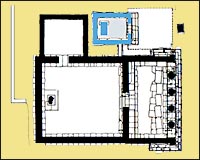The Apaturia was a festival with chiefly a social
content, overshadowing the religious content. It was put
on yearly, the raison d'etre being the
registration of the young men of Athens on the citizen
lists. The name implies the celebration of a "common
paternity", inasmuch as all male members of the phratriae
were descended from a common ancestor. It has not been
established whether there was a parallel procedure for
young girls; however, when a girl got married, the phratria
she belonged to very often made a sacrifice at the
Apaturia. |
 |




